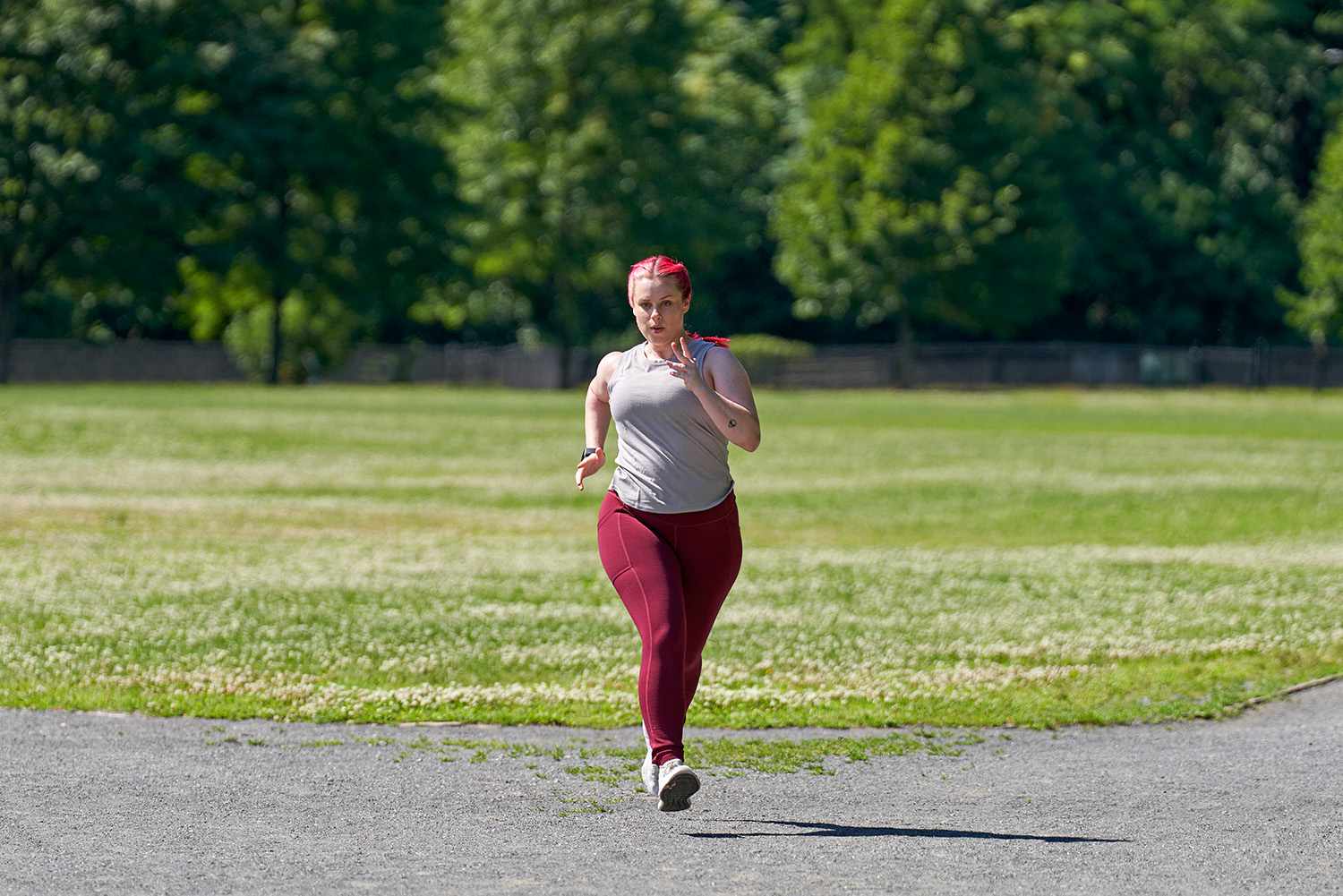

Featured
How To Increase Your Speed In A 5K Run
Modified: January 2, 2024
Featured: Learn effective strategies and tips to increase your speed for a 5K run and achieve your best performance. Get ready to set new personal records and reach your running goals.
Introduction
Welcome to the world of 5K running! Whether you are a seasoned runner looking to improve your speed or a beginner eager to challenge yourself, this article will provide you with valuable insights and strategies to help you increase your speed in a 5K run. A 5K race, which is approximately 3.1 miles, requires a combination of endurance, strength, and speed. While completing a 5K is an impressive accomplishment in itself, pushing yourself to achieve a faster time can be a thrilling and rewarding experience.
Running a 5K at a faster pace not only enhances your overall fitness level but can also ignite your competitive spirit and boost your self-confidence. Improving your speed can be a challenging journey, but with the right training techniques and mindset, you can push your limits and surpass your own expectations.
In this article, we will explore various strategies to help you increase your speed in a 5K run. From proper warm-up and stretching routines to interval training, hill training, plyometric exercises, cross-training, and nutrition, we will cover all the essential aspects of optimizing your performance. Additionally, we will discuss the importance of rest and recovery, as well as proper breathing techniques and mental strategies to keep you focused and motivated during your training and on race day.
Whether you are aiming to achieve a personal best time or simply want to challenge yourself to become a faster runner, the insights shared in this article will serve as a comprehensive guide to help you reach your speed goals. So, lace up your running shoes, get ready to break through your limits, and let’s dive into the world of increasing your speed in a 5K run!
Importance of Speed in 5K Run
Speed is a crucial factor in a 5K run as it directly impacts your overall performance and race results. While endurance is important for longer distances, such as marathons, speed plays a significant role in shorter races like the 5K. Here’s why speed matters in a 5K run:
- Competitive edge: The 5K distance attracts a wide range of runners, from recreational joggers to elite athletes. If you wish to compete against others or even against your personal best, improving your speed is essential. A faster pace allows you to surpass competitors and achieve a higher ranking in races.
- Time goals: Many runners set time goals for their 5K races, aiming to achieve a personal record or beat a specific target. Speed training is key to meet these goals as it enables you to finish the race in a shorter amount of time.
- Mental and physical challenge: Pushing your limits and running at a faster pace requires mental toughness and physical strength. By focusing on speed training, you can challenge yourself both mentally and physically, improving your overall resilience and performance in races.
- Overall fitness: Speed training not only enhances your speed but also improves your overall fitness level. It helps strengthen your cardiovascular system, increase lung capacity, and improve your running efficiency.
- Training variety: Incorporating speed training into your regular running routine adds variety and excitement to your workouts. It breaks the monotony and keeps you engaged, preventing boredom and plateauing in your fitness progress.
While speed is important, it is worth noting that every runner has different goals and priorities. Some may be more focused on endurance and completing the race, while others may prioritize speed. It’s essential to find the right balance between speed training and other aspects of your running routine to achieve optimal results.
In the next sections, we will delve into specific techniques and strategies that can help you boost your speed and improve your performance in a 5K run. From proper warm-up and stretching to interval training and hill workouts, we will explore various training methods that will enhance your speed and endurance. So, let’s continue on this exciting journey to increase your speed in a 5K run!
Proper Warm-up and Stretching
A proper warm-up and stretching routine is essential before any workout or race, including a 5K run. It helps prepare your body for the intense physical activity, reduces the risk of injury, and improves your overall performance. Here are some key tips for warming up and stretching effectively:
- Dynamic Warm-up: Begin your warm-up with dynamic exercises that mimic the movements you’ll be doing during the run. These can include leg swings, walking lunges, high knees, and arm circles. Dynamic warm-up exercises increase blood flow to the muscles, improve range of motion, and prepare your body for the demands of running.
- Joint Mobility Exercises: Pay attention to specific joints that are involved in running, such as ankles, knees, and hips. Perform exercises like ankle circles, knee circles, and hip rotations to improve joint mobility and reduce the risk of injury.
- Light Cardiovascular Activity: Before diving into your run, engage in a few minutes of light aerobic activity like jogging or brisk walking. This helps elevate your heart rate, warm up your muscles, and mentally prepare you for the workout ahead.
Once you have completed your warm-up, it’s time to incorporate stretching exercises into your routine. However, it’s important to note that static stretching, where you hold a stretch for an extended period, should be done after the run or workout. Before running, focus on dynamic stretching, which involves moving through a range of motion to warm up the muscles and improve flexibility.
- Leg Swings: Stand next to a wall or support and swing one leg forward and backward, then side to side. This dynamic stretch targets the hip flexors and hamstrings.
- Walking Lunges: Take a step forward into a lunge position and lower your back knee until it is just above the ground. Push off with your front foot to move into the next lunge. This exercise stretches the hip flexors, quadriceps, and calves.
- Butt Kicks: While jogging in place, aim to kick your heels up towards your glutes. This dynamic stretch targets the quadriceps and prepares them for the running motion.
- Arm Circles: Stand tall with your arms extended to the sides. Make small circles with your arms, gradually increasing the size. This helps warm up the shoulder joints and upper body muscles used during running.
Remember, the goal of warming up and stretching is to increase blood flow, improve flexibility, and activate the muscles you’ll be using during your run. By incorporating a proper warm-up and dynamic stretching routine into your 5K training, you’ll set yourself up for a more efficient and injury-free run. So, take the time to warm up and prepare your body before hitting the pavement!
Interval Training
Interval training is a highly effective method for increasing your speed and endurance in a 5K run. By alternating between periods of intense effort and active recovery, you can push your limits and improve your overall race pace. Here’s how to incorporate interval training into your 5K training regimen:
- Choose Your Intervals: Determine the duration and intensity of your intervals based on your fitness level and goals. For example, you might start with shorter intervals of 200 meters at a faster-than-race-pace effort, followed by a recovery jog or walk for an equal or slightly longer duration. As you progress, you can increase the duration and intensity of the intervals.
- Vary the Intensity: Experiment with different interval intensities to challenge your body. This can include faster sprints, moderate-paced intervals, or even hill sprints. Mixing up the intensity helps improve your overall speed and enables your body to adapt to various running conditions.
- Keep Track of Time or Distance: Use a stopwatch or GPS watch to accurately time your intervals and recovery periods. Alternatively, you can base your intervals on distance markers, such as running hard for a specific distance and then recovering for another distance.
- Gradually Increase the Workload: Start with shorter intervals and gradually increase the total duration or distance covered during your interval workouts. This progressive overload helps your body adapt and improve over time.
- Recovery is Key: Allow yourself sufficient recovery time between intervals. This ensures that you can maintain the quality and intensity of each interval. During the recovery periods, focus on slowing down your pace, catching your breath, and preparing for the next interval.
Interval training not only enhances your aerobic and anaerobic capacity but also improves your body’s ability to clear lactate and sustain a faster pace. By incorporating interval sessions into your training plan, you’ll be able to develop the speed and endurance necessary to achieve your goals in the 5K race.
It’s important to note that interval training can be physically demanding, so it’s crucial to listen to your body and avoid overtraining or pushing yourself too hard too soon. Always warm up properly, and gradually increase the intensity and duration of your intervals as your fitness level improves.
Incorporate interval training sessions into your weekly training routine to supercharge your speed and endurance. These workouts will not only make you a faster runner but also provide a sense of accomplishment and enjoyment. So, lace up your running shoes and get ready to push your limits with interval training!
Hill Training
Hill training is a fantastic way to build strength, improve endurance, and increase your speed in a 5K run. Incorporating hill workouts into your training plan can simulate the demands of race courses with inclines and help you become a more efficient runner. Here’s how you can incorporate hill training into your 5K training regimen:
- Find the Right Hill: Look for a hill that is challenging but manageable for your fitness level. Ideally, it should have a moderate incline and a distance that allows you to complete multiple repetitions without risking exhaustion.
- Warm Up: Begin your hill training session with a dynamic warm-up, as mentioned in the previous section. This will prepare your muscles and joints for the demands of running uphill.
- Start with Hill Repeats: Begin by running up the hill at a steady pace. Focus on maintaining good form, engaging your core, and driving your arms to propel yourself forward. Once you reach the top, jog or walk back down for recovery. Start with a small number of repeats and gradually increase them over time.
- Vary the Length and Intensity: Experiment with different distances and intensities during your hill workouts. You can perform shorter uphill sprints for maximum effort, longer sustained climbs at a slightly lower intensity, or a combination of both. Varying the lengths and intensities of your repeats will help challenge your body in different ways and improve your overall running skills.
- Focus on Form: Running uphill requires additional effort, so it’s important to pay attention to your running form. Keep your body upright, maintain a quick turnover with shorter strides, and push off from your toes. Engaging your glutes and driving your knees forward will help you conquer the hill more efficiently.
- Recover and Repeat: Allow yourself sufficient recovery between hill repeats. This will ensure that you can maintain proper form and effort during each repetition. As you become more experienced and stronger, you can decrease the recovery time between repeats to further challenge yourself.
Hill training not only strengthens your leg muscles but also improves your cardiovascular fitness and running economy. It helps you develop the power and endurance necessary to conquer inclines during a 5K race, enabling you to maintain a faster pace throughout the course.
Remember to gradually increase the difficulty of your hill training sessions as your fitness improves. This will help prevent injuries and allow your body to adapt to the added stress of running uphill.
Incorporate hill training into your weekly routine to build strength, improve your running form, and enhance your speed for the 5K race. Embrace the challenges of uphill running, and you’ll reap the rewards of a stronger and faster runner!
Plyometric Exercises
Plyometric exercises are explosive movements that enhance power, speed, and agility. Incorporating plyometric exercises into your training routine can help you improve your running stride, increase your muscle strength, and enhance your overall speed in a 5K run. Here are some key plyometric exercises to consider:
- Jump Squats: Start in a squat position and explode upward, jumping as high as possible. Upon landing, immediately lower back into a squat and repeat. Jump squats target the muscles in your legs and hips, improving your explosive power and vertical jump.
- Box Jumps: Place a sturdy box or platform in front of you. Jump onto the box, landing softly with your knees slightly bent. Step or jump back down and repeat. Box jumps develop lower body strength and explosiveness, improving your ability to generate power while running.
- Lunge Jumps: Begin with one leg forward in a lunge position. Jump explosively, switching legs in mid-air and landing in a lunge with the opposite leg forward. Continue alternating the lunge jumps. This exercise strengthens your lower body muscles and enhances coordination.
- Burpees: Start in a standing position, then squat down and place your hands on the ground. Jump your feet back into a plank position, perform a push-up, and then jump your feet back towards your hands. Explosively jump upward, reaching your arms overhead. Burpees work multiple muscle groups and improve cardiovascular endurance.
- Single-Leg Bounds: Stand on one leg and propel yourself forward, jumping as far as you can. Land softly on the other leg and immediately transition into the next bound. Single-leg bounds mimic the forward stride motion of running and improve leg strength and power.
When incorporating plyometric exercises into your training routine, it’s important to perform them on a soft surface, such as grass or a specialized training mat, to reduce the impact on your joints. Start with a lower number of repetitions or shorter distances and gradually increase as your body adapts to the demands of plyometric training.
Plyometric exercises should be integrated into your training plan in a controlled and progressive manner to reduce the risk of injuries. Ensure that you have a solid foundation of strength and stability before incorporating advanced plyometric movements.
By including plyometric exercises in your training regimen, you can improve your explosive power, stride efficiency, and speed in a 5K run. These exercises offer a fun and dynamic way to enhance your athleticism and take your running performance to the next level.
Cross-Training
Cross-training, or incorporating other forms of exercise into your training routine, is a valuable strategy to improve your speed and overall performance in a 5K run. Engaging in activities other than running helps to strengthen different muscle groups, prevent overuse injuries, and provide variety in your training. Here are some key benefits and cross-training options to consider:
- Muscle Balance and Injury Prevention: Running primarily works specific muscles, such as your quadriceps and calves. Cross-training allows you to target different muscle groups, promoting better muscle balance and reducing the risk of overuse injuries.
- Improved Cardiovascular Fitness: Cross-training activities like cycling, swimming, or rowing provide an excellent cardiovascular workout that complements your running training. These exercises improve your aerobic capacity, allowing you to run more efficiently and maintain a faster pace.
- Active Recovery: Engaging in low-impact activities, such as yoga or Pilates, can help promote active recovery on your rest days. These activities improve flexibility, core strength, and posture, which in turn supports your running performance and aids in injury prevention.
- Strength Training: Incorporating strength training exercises, such as weightlifting or bodyweight exercises, into your routine helps strengthen your muscles and improve overall power. Targeting your upper body, core, and lower body strengthens the supportive muscles needed for efficient running technique and speed.
- Avoiding Burnout: Constantly running can lead to physical and mental burnout. Cross-training allows you to break up the monotony of running and maintain your motivation and enthusiasm for training.
When choosing cross-training activities, select options that complement your running goals and fit your personal interests. Aim for activities that are enjoyable, sustainable, and help you achieve the specific fitness outcomes you desire.
Remember to listen to your body and adjust the intensity and frequency of your cross-training activities to avoid overexertion. It’s essential to find the right balance between running and cross-training to ensure adequate recovery and prevent excessive fatigue.
Cross-training is a valuable tool in your training arsenal, providing a well-rounded approach to improving your speed and performance in a 5K run. Incorporate cross-training activities that complement your running routine and enhance your overall fitness, and you’ll reap the benefits on race day.
Nutrition and Hydration
Nutrition and hydration play a crucial role in maximizing your performance and speed in a 5K run. Fueling your body with the right nutrients and maintaining proper hydration levels are essential for optimal energy levels, muscle function, and overall endurance. Here are some key tips for nutrition and hydration:
- Pre-Race Fueling: Eat a balanced meal 2 to 3 hours before your race to provide your body with the necessary carbohydrates for energy and protein for muscle repair. Include foods like whole grains, lean proteins, fruits, and vegetables. Avoid heavy or high-fat meals that can cause discomfort during your run.
- Hydration: Proper hydration is critical for maintaining performance and preventing dehydration. Drink water regularly throughout the day leading up to your race. During the 24 hours before your run, aim to consume adequate fluid, and drink about 10 to 20 ounces of water or sports drink 1 to 2 hours before your race. During the run, be sure to take small sips of water at each water station to stay hydrated.
- During-Run Fuel: For a 5K run, you might not need to consume extra fuel during the race itself since your body’s carbohydrate stores should suffice for the duration. However, if you prefer to have some extra energy, you can opt for a small, easily digestible snack like a banana or a sports gel about 30 minutes before your run.
- Recovery Nutrition: After completing your 5K run, replenish your body with a combination of carbohydrates and protein to aid in muscle recovery. Consuming a post-run snack or meal within 30 to 60 minutes after your race can help restore your energy levels and support muscle repair.
- Quality Nutrition: Beyond race day, focus on maintaining a well-rounded, nutrient-dense diet. Consume a balanced mix of carbohydrates, proteins, healthy fats, and plenty of fruits and vegetables. Avoid excessive processed foods, sugary drinks, and alcohol, as they can negatively impact your performance and recovery.
Every individual’s nutritional needs may vary, so it’s essential to experiment during training and listen to your body to understand what works best for you. Consulting with a registered dietitian can provide personalized advice based on your specific goals and needs.
Remember that good nutrition and proper hydration are essential not only for your speed and performance but also for your overall health and well-being. By fueling your body with the right nutrients and staying hydrated, you’ll be giving yourself the best possible chance to perform at your peak in a 5K run.
Rest and Recovery
Rest and recovery are often overlooked aspects of training, but they are essential for improving your speed and performance in a 5K run. Allowing your body time to recover between runs is crucial for muscle repair, injury prevention, and overall performance. Here are some key principles to keep in mind:
- Rest Days: Incorporate rest days into your weekly training schedule. These are days when you completely refrain from running or engaging in any strenuous exercise. Rest days help your muscles recover, reduce the risk of overuse injuries, and replenish energy stores.
- Sleep: Adequate sleep is vital for recovery and performance. Aim for 7 to 9 hours of quality sleep per night. During sleep, your body repairs tissues, produces growth hormones, and consolidates memories. Quality sleep boosts your immune system and promotes overall well-being.
- Active Recovery: On rest days, consider incorporating low-intensity activities, such as gentle stretching, yoga, or walking. These activities promote blood circulation, reduce muscle soreness, and support recovery by increasing the delivery of oxygen and nutrients to your muscles.
- Listen to Your Body: Pay attention to any signs of excessive fatigue, pain, or discomfort. If you feel excessively tired or are experiencing pain, it may be a sign that you need an extra rest day or a lighter workout. Pushing through fatigue or ignoring pain can lead to overtraining and setbacks in your training progress.
- Proper Nutrition: Nutritional support is crucial for recovery. Ensure that you consume adequate protein to aid in muscle repair and carbohydrates to replenish glycogen stores. Include fruits, vegetables, and other nutrient-dense foods in your diet to provide the vitamins and minerals needed for optimal recovery.
Remember that rest and recovery are not signs of weakness but essential components of an effective training plan. By giving your body the time it needs to recover and repair, you’ll promote better performance and reduce the risk of burnout and injury.
Lastly, don’t underestimate the importance of taking regular breaks from training and allowing yourself to enjoy the process. Give yourself permission to relax, engage in other activities, and rejuvenate both physically and mentally. This will help you maintain a healthy and sustainable approach to running and lead to long-term success in improving your speed in a 5K run.
Proper Breathing Techniques
Breathing is a fundamental aspect of running, and mastering proper breathing techniques can significantly improve your speed and endurance in a 5K run. Proper breathing not only provides your muscles with the oxygen they need but also helps maintain a steady rhythm and reduce stress during your run. Here are some key tips for proper breathing techniques:
- Diaphragmatic Breathing: Focus on breathing deeply from your diaphragm rather than shallowly from your chest. This technique allows you to take in more oxygen with each breath and helps your body efficiently deliver oxygen to your muscles.
- Find Your Rhythm: Coordinate your breathing with your running stride. Many runners find it helpful to inhale for two or three strides and exhale for the same number of strides. Experiment with different rhythmic patterns to find what feels most comfortable for you.
- Controlled Breathing: Aim for controlled, rhythmic breathing rather than panting or gasping for air. This helps maintain a steady flow of oxygen to your muscles and prevents the buildup of unnecessary tension and fatigue.
- Breathe Through Your Nose and Mouth: Inhale deeply through both your nose and mouth to maximize oxygen intake. Exhale through your mouth, allowing for a complete release of carbon dioxide and better air exchange.
- Focus on Exhalation: One common mistake is holding your breath or exhaling too forcefully. Focus on fully exhaling and releasing all the air from your lungs before each inhalation. This helps eliminate stale air and allows for a more efficient exchange of oxygen and carbon dioxide.
- Practice Breathing Techniques: Incorporate breathing exercises into your training routine, such as belly breathing or breath control drills, to improve your breathing technique and increase your lung capacity.
Proper breathing techniques can help you maintain a relaxed and efficient running stride, conserve energy, and minimize side stitches or cramps. It is essential to practice these techniques during your training runs to become comfortable with them and integrate them naturally into your running rhythm.
While it can be challenging to focus on your breathing during a race, particularly when pushing yourself to the limit, maintaining a relaxed and controlled breathing pattern can help you stay focused and centered.
Remember that everyone’s breathing preferences and patterns may differ slightly, so it’s important to find what works best for you. Experiment with different techniques during your training runs and listen to your body to discover the breathing rhythm that allows you to perform at your best.
By incorporating proper breathing techniques into your running routine, you’ll optimize your oxygen intake, enhance your endurance, and ultimately improve your speed in a 5K run.
Mental Strategies for Faster Running
Running a faster 5K requires not only physical preparation but also mental strength and resilience. Developing mental strategies and techniques can help you overcome mental barriers, stay focused, and push through discomfort during your race. Here are some key mental strategies to incorporate into your training and racing:
- Visualize Success: Visualization is a powerful tool that can help you mentally prepare for faster running. Imagine yourself running at your desired pace, feeling strong, and crossing the finish line with a sense of accomplishment. Visualization techniques can help build confidence and reinforce positive mental images.
- Set Clear Goals: Establish specific, measurable, and realistic goals for your 5K race. Setting both short-term and long-term goals can provide you with a sense of purpose and motivation. Break down your race into smaller milestones or checkpoints to stay focused and push yourself throughout the run.
- Positive Self-Talk: Be mindful of your inner dialogue and replace any negative or self-defeating thoughts with positive and encouraging affirmations. Instead of telling yourself, “I can’t do this,” replace it with, “I am strong, capable, and ready to conquer this challenge.” Positive self-talk can help boost your confidence and maintain a positive mindset during the race.
- Focus on the Present Moment: Stay present and focus on the current stride, breath, or step. Avoid getting overwhelmed by thinking too far ahead or dwelling on past mistakes. By staying in the present moment, you can maintain focus, make adjustments if needed, and perform at your best.
- Break the Race into Smaller Goals: Dividing the race into smaller segments or milestones can make it more manageable mentally. Focus on reaching the next mile marker, maintaining a certain pace for a specific distance, or passing other runners. Celebrate these small victories along the way to keep yourself motivated and engaged.
- Find Your Mantra: Create a personal mantra or motivational phrase that resonates with you. Repeat it silently or out loud during challenging moments to help you stay focused and push through discomfort. It can be as simple as “I am strong” or “I can do this.”
- Embrace Discomfort: Running at a faster pace can be uncomfortable, both physically and mentally. Embrace the discomfort and see it as a sign of growth and progress. Remind yourself that discomfort is temporary, and you are capable of pushing through it.
- Practice Mindfulness: Incorporate mindfulness techniques into your training to improve your focus and reduce stress. Pay attention to your breath, body sensations, and surroundings during your runs. The practice of mindfulness can help quiet the mind, increase self-awareness, and enhance your overall performance.
Remember that mental strategies take practice and patience. Incorporate these techniques into both your training runs and race simulations to develop mental resilience and improve your ability to perform at your best under pressure.
By cultivating a positive mindset, staying focused, and utilizing mental strategies during your 5K race, you’ll be able to tap into your full potential, overcome mental barriers, and achieve your goals for faster running.
Conclusion
Congratulations on completing this comprehensive guide to increasing your speed in a 5K run! By implementing the strategies and techniques outlined in this article, you now have the tools to optimize your performance and achieve your fastest 5K time yet.
From focusing on proper warm-up and stretching routines to incorporating interval training, hill workouts, plyometric exercises, and cross-training, each aspect plays a crucial role in enhancing your speed and endurance. Additionally, paying attention to nutrition, hydration, rest, recovery, breathing techniques, and mental strategies all contribute to your overall success as a runner.
Remember that every runner’s journey is unique, and results may vary. It’s important to listen to your body, make necessary adjustments, and be patient with the progress you make. Rome wasn’t built in a day, and neither is your speed in a 5K run.
So, lace up your running shoes, set your goals, and embrace the challenges and opportunities that come with increasing your speed in a 5K run. Stay consistent with your training, keep a positive mindset, and believe in yourself. With perseverance and dedication, you will see improvements in your speed and performance over time.
Lastly, always remember to enjoy the journey. Running is not only about achieving faster times but also about the personal growth, self-discovery, and the joy that comes from pushing your limits and reaching new milestones.
Now, go out there, embrace the thrill of running, and let your speed soar in your next 5K race!







